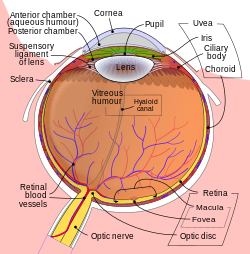Pupil (eye)
| Pupil | |
|---|---|

|
|

Schematic diagram of the human eye.
|
|
| Details | |
| Identifiers | |
| Latin | Pupilla (Plural: Pupillae) |
| TA | A15.2.03.028 |
| FMA | 58252 |
|
Anatomical terminology
[]
|
|
The pupil is a hole located in the center of the iris of the eye that allows light to strike the retina. It appears black because light rays entering the pupil are either absorbed by the tissues inside the eye directly, or absorbed after diffuse reflections within the eye that mostly miss exiting the narrow pupil.
In humans the pupil is round, but other species, such as some cats, have vertical slit pupils, goats have horizontally oriented pupils, and some catfish have annular types. In optical terms, the anatomical pupil is the eye's aperture and the iris is the aperture stop. The image of the pupil as seen from outside the eye is the entrance pupil, which does not exactly correspond to the location and size of the physical pupil because it is magnified by the cornea. On the inner edge lies a prominent structure, the collarette, marking the junction of the embryonic pupillary membrane covering the embryonic pupil.
An anomaly of etymology is that in a surprising number of unrelated languages the meaning of the term for pupil is little person. This may be due to the fact that the reflection of one's image in the pupil is a minuscule version of one's self
The pupil is a hole located in the centre of the iris of the eye that allows light to strike the retina. It appears black because light rays entering the pupil are either absorbed by the tissues inside the eye directly, or absorbed after diffuse reflections within the eye that mostly miss exiting the narrow pupil.
The iris is a contractile structure, consisting mainly of smooth muscle, surrounding the pupil. Light enters the eye through the pupil, and the iris regulates the amount of light by controlling the size of the pupil.
...
Wikipedia
